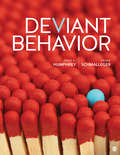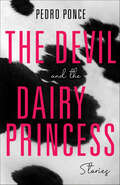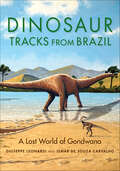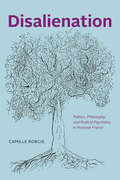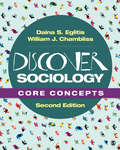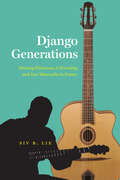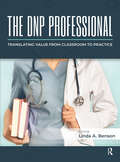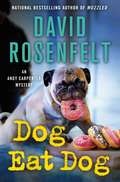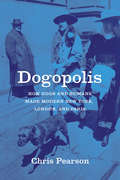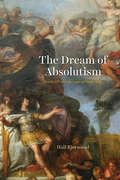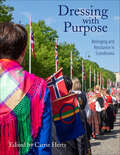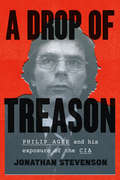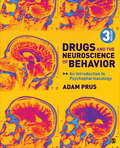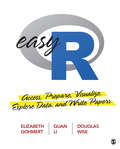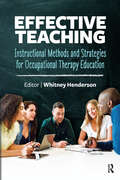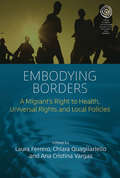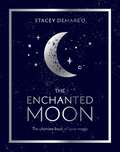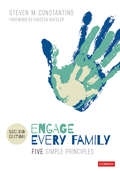- Table View
- List View
Deviant Behavior
by John A. Humphrey Frank A. SchmallegerWhat makes behavior deviant, and who gets to decide what deviance is? Deviant Behavior seeks to answer these questions and more. This compelling new text covers the social forces that shape deviance, the motivations and consequences of deviant behaviors, and how our definition of deviance changes over time. Authors John A. Humphrey and Frank Schmalleger discuss a wide range of deviant behaviors—from criminal acts to extreme forms of everyday behavior—and provide students the necessary foundation to understand the impact of globalization on traditional and emerging forms of deviance. Readers will explore deviance in the modern world using a systematic application of social and criminological theories to a range of deviant behaviors to help them better understand themselves, others, and society. Included with this title: The password-protected Instructor Resource Site (formally known as SAGE Edge) offers access to all text-specific resources, including a test bank and editable, chapter-specific PowerPoint® slides.
Deviant Behavior
by John A. Humphrey Frank A. SchmallegerWhat makes behavior deviant, and who gets to decide what deviance is? Deviant Behavior seeks to answer these questions and more. This compelling new text covers the social forces that shape deviance, the motivations and consequences of deviant behaviors, and how our definition of deviance changes over time. Authors John A. Humphrey and Frank Schmalleger discuss a wide range of deviant behaviors—from criminal acts to extreme forms of everyday behavior—and provide students the necessary foundation to understand the impact of globalization on traditional and emerging forms of deviance. Readers will explore deviance in the modern world using a systematic application of social and criminological theories to a range of deviant behaviors to help them better understand themselves, others, and society. Included with this title: The password-protected Instructor Resource Site (formally known as SAGE Edge) offers access to all text-specific resources, including a test bank and editable, chapter-specific PowerPoint® slides.
The Devil and the Dairy Princess: Stories (Blue Light)
by Pedro PonceWhat happens when the stories we've been told fail us?In ten provocative and unsettling tales, Pedro Ponce grapples with the human instinct to create a narrative out of disparate experiences.The Devil and the Dairy Princess interrogates the power of stories to impact us for good or ill. We are all taught that love is destined to happen with our soul mate and that hard work eventually leads to success. But when faced with circumstances that no longer fit the chosen narrative, some protagonists cling to their outmoded stories with greater fervor, while others realize the old stories no longer suffice, so they choose to inhabit a new reality in stories yet to be told.Perfect for any reader who enjoys literary realism or speculative fiction, The Devil and the Dairy Princess reveals the episodic history of humanity's romance with narrative, from first love to breakup to hopeful reconciliation.
Devshakti Adbhut Divyastra: देवशक्ति अद्भुत दिव्यास्त्र
by Shivendra Suryavanshiशक्ति- एक ऐसा शब्द जिसे प्राप्त करने के लिये, मनुष्य, देवता, दैत्य ही नहीं अपितु अंतरिक्ष के जीव भी सदैव लालायित रहते हैं। शक्ति का पर्याय स्वामित्व से जुड़ता है, इसलिये ब्रह्मांड के सभी जीव शक्ति को प्राप्त कर, स्वयं को श्रेष्ठ दिखाना चाहते हैं। वन में मौजूद एक सिंह भी, अन्य वन्य प्राणियों के समक्ष अपनी शक्ति का प्रदर्शन करने से नहीं चूकता। ठीक उसी प्रकार कुछ देवता भी मनुष्यों के समक्ष, अपना शक्ति प्रदर्शन कर, उनमें भय की भावना उत्पन्न करते रहते हैं। जैसे देवराज इंद्र के द्वारा जलप्रलय लाना या सूर्यदेव के द्वारा सूखे की स्थिति उत्पन्न कर देना। यह सब भी शक्ति प्रदर्शन के अद्वितीय उदाहरण हैं। दैत्यों ने हमेशा त्रिदेवों से ही शक्ति प्राप्त कर, उनका प्रयोग देवताओं के ही विरुद्ध किया है। इन शक्तियों को प्राप्त करने के लिये, मनुष्यों ने भी घोर तप किये हैं। कुछ ऐसी ही देवशक्तियों को, पृथ्वी की सुरक्षा के लिये, देवताओं ने पृथ्वी के अलग-अलग भागों में छिपा दिया, जिससे समय आने पर कुछ दिव्य मानव, उन देव शक्तियों को धारण कर, पृथ्वी की सुरक्षा का भार उठा सकें। ऐसे ही देवशक्ति धारक कुछ विलक्षण मनुष्य बाद में ब्रह्मांड रक्षक कहलाये।
Dinosaur Tracks from Brazil: A Lost World of Gondwana (Life of the Past)
by Giuseppe Leonardi Ismar de CarvalhoDinosaur Tracks from Brazil is the first full-length study of dinosaurs in Brazil. Some 500 dinosaur trackways from the Cretaceous period still remain in the Rio do Peixe basins of Brazil, making it one of the largest trackways in the world. Veteran paleontologists Giuseppe Leonardi and Ismar de Souza Carvalho painstakingly document and analyze each track found at 37 individual sites and at approximately 96 stratigraphic levels. Richly illustrated and containing a wealth of data, Leonardi and de Souza Carvalho brilliantly reconstruct the taxonomic groups of the dinosaurs from the area and show how they moved across the alluvial fans, meandering rivers, and shallow lakes of ancient Gondwana. Dinosaur Tracks from Brazil is essential reading for paleontologists.
Disalienation: Politics, Philosophy, and Radical Psychiatry in Postwar France (Chicago Studies In Practices Of Meaning Ser.)
by Camille RobcisFrom 1940 to 1945, forty thousand patients died in French psychiatric hospitals. The Vichy regime’s “soft extermination” let patients die of cold, starvation, or lack of care. But in Saint-Alban-sur-Limagnole, a small village in central France, one psychiatric hospital attempted to resist. Hoarding food with the help of the local population, the staff not only worked to keep patients alive but began to rethink the practical and theoretical bases of psychiatric care. The movement that began at Saint-Alban came to be known as institutional psychotherapy and would go on to have a profound influence on postwar French thought. In Disalienation, Camille Robcis grapples with the historical, intellectual, and psychiatric meaning of the ethics articulated at Saint-Alban by exploring the movement’s key thinkers, including François Tosquelles, Frantz Fanon, Félix Guattari, and Michel Foucault. Anchored in the history of one hospital, Robcis's study draws on a wide geographic context—revolutionary Spain, occupied France, colonial Algeria, and beyond—and charts the movement's place within a broad political-economic landscape, from fascism to Stalinism to postwar capitalism.
Discover Sociology: Core Concepts
by William J. Chambliss Daina S. Eglitis2020 SAGE Keith Roberts Teaching Innovations Award—enabling graduate students and early career faculty to attend the annual ASA pre-conference teaching and learning workshop. Discover Sociology: Core Concepts explores sociology as a discipline of curious minds, with the theoretical, conceptual, and empirical tools needed to understand, analyze, and even change the world. It is adapted from Discover Sociology, Fourth Edition and offers in-depth coverage of 12 high-priority topics that are at the core of almost all introductory sociology courses. The Second Edition of Core Concepts maintains its reader-friendly narrative and the hallmark themes of the parent book, including the unequal distribution of power in society ("Inequality Matters"), the sociological imagination ("Private Lives, Public Issues"), career skills ("What Can I Do With a Sociology Degree?") and civil discourse ("Discover and Debate"). In response to reader’s requests, this edition features expanded coverage of issues such as intersectionality, popular culture, and changes in the contemporary population of college students in the U.S. Additionally, updated social indicators bring in the latest data available from the U.S. Census Bureau, the Bureau of Labor Statistics, the Centers for Disease Control and Prevention, and the Pew Research Center, among others, to ensure that discussions and figures remain timely. This title is accompanied by a complete teaching and learning package. Digital Option / Courseware SAGE Vantage is an intuitive digital platform that delivers this text’s content and course materials in a learning experience that offers auto-graded assignments and interactive multimedia tools, all carefully designed to ignite student engagement and drive critical thinking. Built with you and your students in mind, it offers simple course set-up and enables students to better prepare for class. Assignable Video with Assessment Assignable video (available with SAGE Vantage) is tied to learning objectives and curated exclusively for this text to bring concepts to life. LMS Cartridge (formerly known as SAGE Coursepacks): Import this title’s instructor resources into your school’s learning management system (LMS) and save time. Don’t use an LMS? You can still access all of the same online resources for this title via the password-protected Instructor Resource Site. SAGE Lecture Spark: Designed to save you time and ignite student engagement, these free weekly lecture launchers focus on current event topics tied to key concepts in Sociology.
Discover Sociology: Core Concepts
by William J. Chambliss Daina S. Eglitis2020 SAGE Keith Roberts Teaching Innovations Award—enabling graduate students and early career faculty to attend the annual ASA pre-conference teaching and learning workshop. Discover Sociology: Core Concepts explores sociology as a discipline of curious minds, with the theoretical, conceptual, and empirical tools needed to understand, analyze, and even change the world. It is adapted from Discover Sociology, Fourth Edition and offers in-depth coverage of 12 high-priority topics that are at the core of almost all introductory sociology courses. The Second Edition of Core Concepts maintains its reader-friendly narrative and the hallmark themes of the parent book, including the unequal distribution of power in society ("Inequality Matters"), the sociological imagination ("Private Lives, Public Issues"), career skills ("What Can I Do With a Sociology Degree?") and civil discourse ("Discover and Debate"). In response to reader’s requests, this edition features expanded coverage of issues such as intersectionality, popular culture, and changes in the contemporary population of college students in the U.S. Additionally, updated social indicators bring in the latest data available from the U.S. Census Bureau, the Bureau of Labor Statistics, the Centers for Disease Control and Prevention, and the Pew Research Center, among others, to ensure that discussions and figures remain timely. This title is accompanied by a complete teaching and learning package. Digital Option / Courseware SAGE Vantage is an intuitive digital platform that delivers this text’s content and course materials in a learning experience that offers auto-graded assignments and interactive multimedia tools, all carefully designed to ignite student engagement and drive critical thinking. Built with you and your students in mind, it offers simple course set-up and enables students to better prepare for class. Assignable Video with Assessment Assignable video (available with SAGE Vantage) is tied to learning objectives and curated exclusively for this text to bring concepts to life. LMS Cartridge (formerly known as SAGE Coursepacks): Import this title’s instructor resources into your school’s learning management system (LMS) and save time. Don’t use an LMS? You can still access all of the same online resources for this title via the password-protected Instructor Resource Site. SAGE Lecture Spark: Designed to save you time and ignite student engagement, these free weekly lecture launchers focus on current event topics tied to key concepts in Sociology.
Diversity's Child: People of Color and the Politics of Identity
by Efrén O. PérezAn incisive look at how America’s continued demographic explosion has spurred the development of a new identity as people of color. For decades now, pundits and political scientists have been pointing to a major demographic change that’s underway in the United States. Demographers project that whites will become a minority of the US population and that minority groups will jointly comprise a majority before 2050. Diversity’s Child appraises the political ramifications of this change. Efrén O. Pérez deftly argues that America’s changing demographics are forging a new identity for many as people of color—that unifies the political outlook of assorted minority groups. Drawing on opinion surveys of multiple minority groups, social science experiments with minority adults, content analyses of newspapers and congressional archives, and in-depth interviews with minority individuals, Pérez makes two key points. First, a person of color's identity does exist, and we can reliably measure it, as well as distinguish it from other identities that minorities hold. Second, across a wide swath of circumstances, identifying as a person of color profoundly shapes how minorities view themselves and their political system. Diversity’s Child is a vital and engaging look at America’s identity politics as well as at how people of color think about racial disparities and how politics can best solve them.
Django Generations: Hearing Ethnorace, Citizenship, and Jazz Manouche in France (Chicago Studies in Ethnomusicology)
by Siv B. LieDjango Generations shows how relationships between racial identities, jazz, and national belonging become entangled in France. Jazz manouche—a genre known best for its energetic, guitar-centric swing tunes—is among France’s most celebrated musical practices of the twentieth and twenty-first centuries. It centers on the recorded work of famed guitarist Django Reinhardt and is named for the ethnoracial subgroup of Romanies (also known, often pejoratively, as “Gypsies”) to which Reinhardt belonged. French Manouches are publicly lauded as bearers of this jazz tradition, and many take pleasure and pride in the practice while at the same time facing pervasive discrimination. Jazz manouche uncovers a contradiction at the heart of France’s assimilationist republican ideals: the music is portrayed as quintessentially French even as Manouches themselves endure treatment as racial others. In this book, Siv B. Lie explores how this music is used to construct divergent ethnoracial and national identities in a context where discussions of race are otherwise censured. Weaving together ethnographic and historical analysis, Lie shows that jazz manouche becomes a source of profound ambivalence as it generates ethnoracial difference and socioeconomic exclusion. As the first full-length ethnographic study of French jazz to be published in English, this book enriches anthropological, ethnomusicological, and historical scholarship on global jazz, race and ethnicity, and citizenship while showing how music can be an important but insufficient tool in struggles for racial and economic justice.
The DNP Professional: Translating Value from Classroom to Practice
by Linda BensonThe DNP Professional: Translating Value from Classroom to Practice is a collection of exemplars from DNP (Doctor of Nursing Practice) -prepared experts across various advanced practice nursing roles and settings. The content illustrates the application of the American Association of Colleges of Nursing’s “Essentials,” quantifies successful DNP-prepared practitioner outcomes, and describes the overall impact of the nursing practice doctorate. Each chapter is written by a different expert and focuses on how the Essentials relate to that author’s role, including business planning, evidence-driven decision making, data analytics, and interprofessional collaboration. These leaders demonstrate how to implement lessons learned in a DNP program and translate them into everyday practice in every nursing domain, with plenty of pearls to pass along. Editor Linda A. Benson has divided the book into sections based on roles and settings: • Nurse Practitioner • Clinical Nurse Specialist • Certified Registered Nurse Anesthetists • Nurse Midwife • Nurse Executive • Academia • Population Health • Informatics • Legislative Activity When performing at their peak, DNPs can affect clinical, satisfaction, and cost outcomes, as well as provide preceptorship and mentoring. With exemplars from across the continuum of practice sites and roles, The DNP Professional: Translating Value from Classroom to Practice enables both students and DNP graduates to optimize the curricular Essentials in the practice setting.
Dog Eat Dog: An Andy Carpenter Mystery (An Andy Carpenter Novel #23)
by David RosenfeltLawyer Andy Carpenter and his golden retriever, Tara, work to free a man who risked it all to help a dog in need Lawyer Andy Carpenter and his wife, Laurie, enjoy walking their dogs, Tara and Sebastian. By this point in their marriage, it’s routine. When out for one of their strolls, their simple ritual isn’t so simple anymore. Across the street, a man is mistreating his dog. Three things happen at once: Andy yells, Laurie runs to stop the abuse, and so does a closer passerby, who so thoroughly beats the owner that both are arrested when the cops arrive.Andy scoops up the dog and takes him to the Tara Foundation, the dog rescue organization that’s always been his true passion. Meanwhile, at the police station, the passerby is identified as Matthew Jantzen, and he’s wanted for murder. Andy and Laurie are struck by the fact that Jantzen, a man on the run, would nevertheless intervene to help a dog, and decide to find out more.Dog Eat Dog, the twenty-second installment in the Andy Carpenter series, features the charming cast of characters - old and new - that David Rosenfelt is known for and the dogs that accompany them.
Dogopolis: How Dogs and Humans Made Modern New York, London, and Paris (Animal Lives Ser.)
by Chris PearsonDogopolis presents a surprising source for urban innovation in the history of three major cities: human-canine relationships. Stroll through any American or European city today and you probably won’t get far before seeing a dog being taken for a walk. It’s expected that these domesticated animals can easily navigate sidewalks, streets, and other foundational elements of our built environment. But what if our cities were actually shaped in response to dogs more than we ever realized? Chris Pearson’s Dogopolis boldly and convincingly asserts that human-canine relations were a crucial factor in the formation of modern urban living. Focusing on New York, London, and Paris from the early nineteenth century into the 1930s, Pearson shows that human reactions to dogs significantly remolded them and other contemporary western cities. It’s an unalterable fact that dogs—often filthy, bellicose, and sometimes off-putting—run away, spread rabies, defecate, and breed wherever they like, so as dogs became a more and more common in nineteenth-century middle-class life, cities had to respond to people’s fear of them and revulsion at their least desirable traits. The gradual integration of dogs into city life centered on disgust at dirt, fear of crime and vagrancy, and the promotion of humanitarian sentiments. On the other hand, dogs are some people’s most beloved animal companions, and human compassion and affection for pets and strays were equally powerful forces in shaping urban modernity. Dogopolis details the complex interrelations among emotions, sentiment, and the ways we manifest our feelings toward what we love—showing that together they can actually reshape society.
The Dream of Absolutism: Louis XIV and the Logic of Modernity
by Hall BjørnstadThe Dream of Absolutism examines the political aesthetics of power under Louis XIV. What was absolutism, and how did it work? What was the function of the ostentatious display surrounding Louis XIV at Versailles? What is gained—and what is lost—by approaching such expressions of absolutism as propaganda, as present-day scholars tend to do? In this sweeping reconsideration of absolutist culture, Hall Bjørnstad argues that the exuberance of Louis XIV’s reign was not top-down propaganda in any modern sense, but rather a dream dreamt collectively, by king, court, image-makers, and nation alike. Bjørnstad explores this dream through a sustained close analysis of a corpus of absolutist artifacts, ranging from Charles Le Brun’s famous paintings in the Hall of Mirrors at Versailles via the king’s secret Mémoires to two little-known particularly extravagant verbal and textual celebrations of the king. The dream of absolutism, Bjørnstad concludes, lives at the intersection of politics and aesthetics. It is the carrier of a force that emerges as a glorious image; a participatory emotional reality that requires reality to conform to it. It is a dream, finally, that still shapes our collective political imaginary today.
Dressing with Purpose: Belonging and Resistance in Scandinavia
by Carrie HertzDress helps us fashion identity, history, community, and place. Dress has been harnessed as a metaphor for both progress and stability, the exotic and the utopian, oppression and freedom, belonging and resistance. Dressing with Purpose examines three Scandinavian dress traditions—Swedish folkdräkt, Norwegian bunad, and Sámi gákti—and traces their development during two centuries of social and political change across northern Europe. By the 20th century, many in Sweden worried about the ravages of industrialization, urbanization, and emigration on traditional ways of life. Norway was gripped in a struggle for national independence. Indigenous Sámi communities—artificially divided by national borders and long resisting colonial control—rose up in protests that demanded political recognition and sparked cultural renewal. Within this context of European nation-building, colonial expansion, and Indigenous activism, traditional dress took on special meaning as folk, national, or ethnic minority costumes—complex categories that deserve reexamination today. Through lavishly illustrated and richly detailed case studies, Dressing with Purpose introduces readers to individuals who adapt and revitalize dress traditions to articulate who they are, proclaim personal values and group allegiances, strive for sartorial excellence, reflect critically on the past, and ultimately, reshape the societies they live in.
A Drop of Treason: Philip Agee and His Exposure of the CIA
by Jonathan StevensonPhilip Agee’s story is the stuff of a John le Carré novel—perilous and thrilling adventures around the globe. He joined the CIA as a young idealist, becoming an operations officer in hopes of seeing the world and safeguarding his country. He was the consummate intelligence insider, thoroughly entrenched in the shadow world. But in 1975, he became the first such person to publicly betray the CIA—a pariah whose like was not seen again until Edward Snowden. For almost forty years in exile, he was a thorn in the side of his country. The first biography of this contentious, legendary man, Jonathan Stevenson’s A Drop of Treason is a thorough portrait of Agee and his place in the history of American foreign policy and the intelligence community during the Cold War and beyond. Unlike mere whistleblowers, Agee exposed American spies by publicly blowing their covers. And he didn’t stop there—his was a lifelong political struggle that firmly allied him with the social movements of the global left and against the American project itself from the early 1970s on. Stevenson examines Agee’s decision to turn, how he sustained it, and how his actions intersected with world events. Having made profound betrayals and questionable decisions, Agee lived a rollicking, existentially fraught life filled with risk. He traveled the world, enlisted Gabriel García Márquez in his cause, married a ballerina, and fought for what he believed was right. Raised a conservative Jesuit in Tampa, he died a socialist expat in Havana. In A Drop of Treason, Stevenson reveals what made Agee tick—and what made him run.
Drugs and the Neuroscience of Behavior: An Introduction to Psychopharmacology
by Adam PrusDrugs and the Neuroscience of Behavior presents an introduction to the rapidly advancing field of psychopharmacology by examining how drug actions in the brain affect psychological processes. Author Adam Prus provides historical background to give readers an appreciation for the development of drug treatments and neuroscience over time, covering major topics in psychopharmacology including new drugs and recent trends in drug use. Empirically supported pedagogical features offer students the opportunity to reflect on what they read to ensure understanding before progressing to new content. The Third Edition includes a new chapter on depressants and discussions of major topics such as the opioid epidemic, the risks associated with vaping, and MDMA-assisted psychotherapy for PTSD. Included with this title: The password-protected Instructor Resource Site (formally known as SAGE Edge) offers access to all text-specific resources, including a test bank and editable, chapter-specific PowerPoint® slides.
Drugs and the Neuroscience of Behavior: An Introduction to Psychopharmacology
by Adam PrusDrugs and the Neuroscience of Behavior presents an introduction to the rapidly advancing field of psychopharmacology by examining how drug actions in the brain affect psychological processes. Author Adam Prus provides historical background to give readers an appreciation for the development of drug treatments and neuroscience over time, covering major topics in psychopharmacology including new drugs and recent trends in drug use. Empirically supported pedagogical features offer students the opportunity to reflect on what they read to ensure understanding before progressing to new content. The Third Edition includes a new chapter on depressants and discussions of major topics such as the opioid epidemic, the risks associated with vaping, and MDMA-assisted psychotherapy for PTSD. Included with this title: The password-protected Instructor Resource Site (formally known as SAGE Edge) offers access to all text-specific resources, including a test bank and editable, chapter-specific PowerPoint® slides.
The Dunning-Kruger Effect: A Novel
by Andrés StoopendaalAn over-educated, under-employed man struggles to complete his novel and get his life together over the course of one scorching hot Swedish summer in this clever, provocative, and hilarious novel that is already an acclaimed sensation abroad.Convinced of his own moral and intellectual superiority, the nameless protagonist of this debut novel is also paralyzed by self-consciousness. Yet, inspired by Stephen King&’s On Writing, he decides to dedicate four hours a day to work on his own novel over the course of one summer. Only, he must also balance his creative goals with a part-time government job and looking after his girlfriend&’s possibly brain-damaged Pomeranian dog. Too bad he&’s uninspired by his job, almost kills the dog, and realizes his novel is slowly morphing into misguided fan fiction about French writer and enfant terrible Michel Houellebecq. Even when he&’s alone, he can&’t help but pontificate before an imagined audience, making over-the-top cases for and against all manner of culture war battles, referencing everyone from Spike Lee to Grumpy Cat. He obsesses over identity politics, and veers into dangerous territory as he and his androgynous girlfriend engage in sexual role-play. He&’s an emblem of all the follies of our age—happily unaware that in his refusal to be ordinary, he&’s become a walking cliché of misguided manhood. The Dunning-Kruger Effect is a portrait of a person belatedly coming of age, a blistering takedown of a privileged man who believes he&’s a revolutionary, and &“a crackling firework display of comic brilliance&” (Svenska Dagbladet, Sweden).
Easy R: Access, Prepare, Visualize, Explore Data, and Write Papers
by Elizabeth A. Gohmert Quan L. Li Douglas R. WiseDo you want to learn R? This book is built on the premise that anyone with a bit of free time and a healthy curiosity can learn to use R in their studies or at work. The authors focus on using R to do useful things like writing reports, creating data and graphs, accessing datasets collected by others, preparing data, and conducting simple data analysis. In this book you’ll learn how to: install R and RStudio®, and set up an RStudio® project and folders; write an essay with graphs based on simple real-world data using R Markdown; create variables from everyday numeric information and visualize data through five types of charts—bar plot, histogram, pie chart, scatter plot, and time series line plot—to identify patterns in the data; write and run R programs, and prepare your data following the tidyverse approach; import external datasets into R, install R data packages, and carry out initial data validity checks; conduct exploratory data analysis through three exercises involving data on voting outcomes, natural resource consumption, and gross domestic product (GDP) via data visualization, correlation coefficient, and simple regression; and write a research paper on the impact of GDP per capita on life expectancy using R Markdown. Student-friendly language and examples (such as binge-watched shows on Netflix, and the top 5 songs on Spotify), cumulative learning, and practice exercises make this a must-have guide for a variety of courses where data are used and reports need to be written. Code and datasets used to carry out the examples in the book are available on an accompanying website.
Easy R: Access, Prepare, Visualize, Explore Data, and Write Papers
by Elizabeth A. Gohmert Quan L. Li Douglas R. WiseDo you want to learn R? This book is built on the premise that anyone with a bit of free time and a healthy curiosity can learn to use R in their studies or at work. The authors focus on using R to do useful things like writing reports, creating data and graphs, accessing datasets collected by others, preparing data, and conducting simple data analysis. In this book you’ll learn how to: install R and RStudio®, and set up an RStudio® project and folders; write an essay with graphs based on simple real-world data using R Markdown; create variables from everyday numeric information and visualize data through five types of charts—bar plot, histogram, pie chart, scatter plot, and time series line plot—to identify patterns in the data; write and run R programs, and prepare your data following the tidyverse approach; import external datasets into R, install R data packages, and carry out initial data validity checks; conduct exploratory data analysis through three exercises involving data on voting outcomes, natural resource consumption, and gross domestic product (GDP) via data visualization, correlation coefficient, and simple regression; and write a research paper on the impact of GDP per capita on life expectancy using R Markdown. Student-friendly language and examples (such as binge-watched shows on Netflix, and the top 5 songs on Spotify), cumulative learning, and practice exercises make this a must-have guide for a variety of courses where data are used and reports need to be written. Code and datasets used to carry out the examples in the book are available on an accompanying website.
Effective Teaching: Instructional Methods and Strategies for Occupational Therapy Education
by Whitney HendersonGrounded in research and experience, Effective Teaching: Instructional Methods and Strategies for Occupational Therapy Education offers practical examples of various types of instructional methods and theoretical models for educators in occupational therapy and other allied health professions to use in evidence-based teaching. Dr. Whitney Henderson includes the latest trends and methods used in education to facilitate student-centered learning. With an easy-to-understand overview of each technique presented, allied health educators can follow step-by-step details to implement various evidence-based instructional methods. Each chapter of Effective Teaching contains: Description of the instructional method Evidence supporting use of the method Discussion of a learning theory and how the method relates to this theory Discussion of how to use the method to develop clinical reasoning Advantages and disadvantages of the method Examples of classroom use Application of the method to a professional situation With excellent explanations of theoretical foundations, ‘how-to’ methods and models, and strategies for educators to employ, Effective Teaching: Instructional Methods and Strategies for Occupational Therapy Education is a one-stop shop for implementing unique and useful instructional methods in educational courses.
Embodying Borders: A Migrant’s Right to Health, Universal Rights and Local Policies (EASA Series #41)
by Laura Ferrero, Chiara Quagliariello Ana Cristina VargasBased on extensive field research, the essays in this volume illuminate the experiences of migrants from their own point of view, providing a critical understanding of the complex social reality in which each experience is grounded. Access to medical care for migrants is a fundamental right which is often ignored. The book provides a critical understanding of the social reality in which social inequalities are grounded and offers the opportunity to show that right to health does not correspond uniquely with access to healthcare.
The Enchanted Moon
by Stacey DemarcoA Guide to Australian Weddings helps you to plan the most important event in your life. And it's full of information for everyone involved in planning or taking part in a wedding—including your family, bridal party, and friends. All the finer details of getting married—the presents, invitations, organizing the ceremony and reception, how to handle the tricky problems that arise when parents are divorced, finding the right wedding gowns and suits, choosing flowers and selecting photographers, dealing with caterers, and how to make speeches—are explained in a helpful, practical way. A Guide to Australian Weddings unlocks all the mysteries of wedding etiquette and is packed with useful checklists and schedules so your marriage will go without a hitch. This is your complete guide to a perfect day.
Engage Every Family: Five Simple Principles
by Steven Mark ConstantinoNew and Improved - Revisit Five Simple Principles and Engage With Every Family Why haven’t we been more successful in engaging every family in the educational lives of their children? Why do we still struggle with the notion of engaging every family as a conduit to improved student learning? This book outlines a pathway and process to engage every family, including those families that have been traditionally disengaged or disenfranchised. Updates to this second edition include updated research to ensure a firmer foundation for each of its five simple principles as well as: - Reflections about implicit bias, equitable learning outcomes, and the role family engagement plays - A deeper dive into the idea of family efficacy, or empowering families to work alongside teachers for improved learning - A nuanced switch from building to developing relationships, and how trust is at the core of that subtle difference Join Dr. Steve Constantino as he shares what he has learned and how he has improved the Five Simple Principles for family engagement and its powerful effects upon student achievement.
